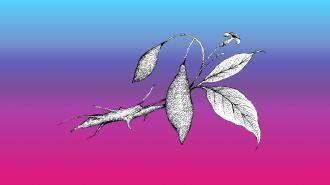A team of researchers has developed a suite of novel drugs for depression, inspired by ibogaine — a potent psychedelic drug and a key component of religious rites — and cold computer science. The strongest candidates showed signs of treating addiction, anxiety, and depression in mice — with an efficacy exceeding popular antidepressant Paxil.
These new compounds hit the same target as antidepressants known as SSRIs, the serotonin transporter, or SERT. Although they’re similar to ibogaine in many ways, they’re not just reinventing the drug as it’s found in nature.
“Some people swear by ibogaine for treating addiction, but it isn’t a very good drug,” Brian Shoichet, a professor in the UCSF school of pharmacy and co-senior author of the study, said.
“It has bad side effects, and it’s not approved for use in the U.S. Our compounds mimic just one of ibogaine’s many pharmacological effects, and still replicate its most desirable effects on behavior, at least in mice.”
Researchers has developed a suite of novel drugs for depression, inspired by ibogaine — a potent psychedelic drug and a key component of religious rites — and cold computer science.
“Prototype for discovery”: Ibogaine is derived from the roots of the iboga plant (Tabernanthe iboga Baill), native to central Africa, which is used ritualistically by various cultures — notably practitioners of Bwiti in Gabon. It has shown some efficacy as an anti-addiction treatment, particularly for opioid addiction, but a dearth of funds and drug scheduling issues have limited research — that, and its side-effects.
The plant can cause fairly intense dissociative experiences that could be unpleasant for some patients, and importantly, it can cause cardiac issues, including arrhythmias. This combination of potency — it’s been found to help with not only detox in opioid patients, curbing brutal withdrawal symptoms, but also repressing continued urges to use — and potential pitfalls makes ibogaine the “Mt. Everest of psychedelics,” UC-Davis associate professor David Olson told NPR in 2020.
Despite those drawbacks, ibogaine “may provide a useful prototype for discovery and development of innovative pharmacotherapy of addiction,” NYU’s Kenneth Alper wrote back in 2017 in The American Journal of Drug and Alcohol Abuse.
And that is where the field has been going; researchers, including Olson, developed an ibogaine-inspired compound called TBG that has seen success treating mouse models of addiction.
Ibogaine has shown promise as an anti-addiction treatment, particularly for opioid addiction, but a dearth of funds and drug scheduling issues have limited research — that, and its side-effects.
Aiming for SERT: The UCSF researchers, joined by colleagues at Duke and Yale, used ibogaine’s impact on the serotonin transporter, SERT, to start their hunt for new potential drugs.
In their study, published in Cell, the researchers used a technique called “computational docking” to help suss out SERT-hitting candidates from a massive library of molecules.
Shoichet’s docking method matches candidate molecules with a given protein, simulating how well they will bind together.
“This kind of project begins with visualizing what kinds of molecules will fit into a protein, docking the library, optimizing and then relying on a team to show the molecules work,” said Isha Singh, a co-first author who worked on the study as a postdoc in Shoichet’s lab.
In the first round of docking, the team whittled down a library of potential SERT inhibitors from 200 million to just 49. Of those, 36 of them were able to be chemically synthesized. When they were tested in the Yale lab of Gary Rudnik, 13 were found to actually inhibit SERT.
The team then helped Singh select the five most promising compounds for optimization, which were tested on mouse models of anxiety, depression, and addiction.
“All of a sudden, they popped — that’s when these drugs looked a lot more potent than even paroxetine [Paxil],” Shoichet said.
The compounds were found effective at treating symptoms of depression and addiction. When they were examined using cryo-electron microscopy, the team could see that the candidates inhibited SERT in a way that’s similar to ibogaine. Importantly, they seemed to do so without binding to a bunch of other proteins — a key driver of ibogaine’s side effects.
“Ibogaine binds to [the gene] hERG, which can cause heart arrhythmias, and from a scientific standpoint, it’s a ‘dirty’ drug, binding to lots of targets beyond SERT,” Shoichet said.
In addition to their drug candidates, the research illuminates ibogaine itself. “Before this experiment, we didn’t even know if the benefits of ibogaine came from its binding to SERT,” Shoichet said.
The compounds were found effective at treating symptoms of depression and addiction in mice.
Next steps: The structure of the two most promising SERT inhibitors has been sent to chemical manufacturer Sigma Aldrich, with the intent of producing them to make them available for study.
“This is really the way science should be done,” Basbaum said. “We took a group with expertise in disparate fields and came up with something that might really make a difference.”
We’d love to hear from you! If you have a comment about this article or if you have a tip for a future Freethink story, please email us at [email protected].





